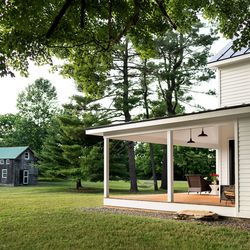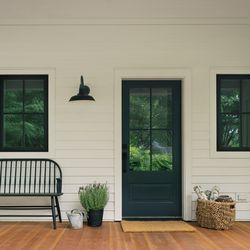Some folks like to joke that an old country house is held together with spit and baling wire. But Chris Colomello, a general contractor in Amenia, New York, doesn’t kid around. “We do it all the time,” he says, referring to the steel ties his crew tightened overhead in this once-quaking 19th-century house. “It keeps the exterior walls from pushing apart.” By all outward appearances the post-and-beam, timber-framed antique was fine. But dips in the floors suggested otherwise. “We did some investigating and found sections of floor joists that were cut out at some point to run ductwork,” Colomello recalls. “It was a scary thing to find because by no means was this house structurally sound.” Homeowners Brian and Alexandra Tart waited 15 years before figuring the time was ripe to renovate. Their decision sprang less from fears the walls would pull apart and more from a desire to jack up the house’s light and efficiency. “We didn’t want a different house,” Alex says. “Just a better-functioning one.” The windows in back hardly captured the view, the kitchen felt dated and cramped, and there were just two bedrooms and a shared bath upstairs for the couple and their twin boys. The house, at 2,140 square feet, wasn’t too small exactly, but it was disjointed. The couple had acquired the two-bedroom, two-bath place as a weekend retreat, complete with a collapsing barn, after Brian’s aunt, an architect, flagged the area as inviting. “She had bought property there and said, ‘You should come up here—they just extended the train line,’” Brian says. They were newlyweds, living in a one-bedroom in Manhattan, with busy jobs that called for a way “to unplug and recharge,” as Brian puts it. It all happened very quickly. The two were so green that they not only bid the asking price but also thought nothing of nabbing a 10-foot dining table at a Midtown flea market, strapping it to the top of their Subaru, and crawling all the way upstate. This neck of Dutchess County was pretty quiet at the time; at first their social life consisted of playing Scrabble with a 92-year-old neighbor. But they kept up the commute, which got them out of the city and away from work, while getting to know the house and its 2½ acres, quirk by quirk. “The well went dry immediately,” Brian recalls. “It went down only 20 feet.” They painted inside and out, retiled both showers, laughed off the first floor’s low ceilings (Brian is not short)—and hired a douser, “a psychic who works remotely,” Brian says, who guided them toward water—500 feet down. After twins Andrew and James arrived on the scene, and the family moved into a 1901 fixer-upper in Brooklyn, everyone was glad to have a yard where you could kick around a ball. Over time, the couple patched the fencing and raised garden beds, replaced some windows, and restored the barn, where Brian now parks his table saw and log splitter. Nothing in the house was level or plumb. The first floor sank at the center, one exposed collar tie upstairs was visibly bowed, and the windows that hadn’t been replaced blew cold air. The kitchen squatted in a one-story addition that went back to the 1970s or 1980s—no one knows for sure. The addition’s history wasn’t the only unknown. Town and county records are skimpy, with little documentation about when or how the house was altered over the years or even when it was built. Betsy Strauss of the Amenia Historical Society thinks a couple named the Reeds, who married in 1803, probably built the house around then to raise their family in what was an emerging hamlet near the Connecticut border, bristling with farms, mills, factories, and blacksmiths. Others have told the Tarts it may have been a meetinghouse—the rooms, baths included, are oddly large—and surmised that it may have been moved from another site, perhaps to house tenant farmers. With a chimney but no trace of an original fireplace or kitchen, and a mix of plaster and drywall, it’s unclear what was done to the structure or when. The town gradually moved up in the world, thanks partly to that rail spur—picture a modern-day milk train delivering folks from the city. In 2015, plans were laid for a luxury golf-course resort and gated community, and the rush was on. It made sense to enlarge and enhance a beloved old house with stunning views and well-kept gardens. As sometimes happens, Alex had met their architect, Jill Porter, on their kids’ kindergarten playground in Brooklyn. Porter had renovated her own weekend place nearby. She got to know the couple’s house, and they eventually started talking. “When I mentioned reorienting the views, Jill said, ‘I see something glassy,’” Alex says. “She had me at that word. She also said, ‘It’s a humble house, so it’s important to get the massing right.’” “It sounds trite, but they loved their house,” Porter says. “It’s very deep, their affection for their home.” So there would be no big alterations to the layout of the existing rooms in the original portion, only a seamless addition scaled and proportioned to pay homage to the 19th-century house—coupled with a few long-awaited fixes so discreet they look original, too. The team soon included a structural engineer, Tim Lynch, who helped suss out flaws in the structure and ways to fix them. Colomello prepared for battle by moving the fridge into the living room and the coffee maker into the bath, then demolished the old addition and its patio, reinforced the exterior wall, and excavated a foundation for the new addition, which would hold the kitchen, sitting area, and mudroom under a primary suite. Tinkering with the old portion of the house included sistering joists and pumping up daylight in an attic bonus room by way of two new windows. The team opened up the main staircase by demolishing a wall that enclosed it and inserting an airy balustrade. Creaky old stairs to the attic came out in favor of a proper staircase set against the rear wall that takes a space-saving turn. Getting the old and new portions of the house to jibe involved shifting the location of an upstairs window to accommodate new rooflines. On the first floor, the team peeled up the original heart pine floorboards to make way for a new HVAC system; instead of subflooring, they found joists made from hand-hewn tree trunks. The basement, bordered by a rubblestone foundation, kept its dirt floor but absorbed a new gas boiler and propane-fed water heater; an electric sump pump and new footing drains help keep it dry. To reduce energy loss without weighing down the roof’s old hand-cut rafters, the crew suspended an insulated roof system right over the old one. The few original windows left were upgraded and several new ones added, helping seal up the place. Previous owners had removed the attic floor over the larger of the existing bedrooms, yielding a cathedral ceiling while bringing in light from the attic windows and creating a loft space reached by a ladder tucked in a closet. That left a portion of the attic enclosed as a bonus room. The loft space, meanwhile, lives on, maintaining airiness and light in a kids’ bedroom. Porter used new heart-pine floorboards to help everything blend in. The couple kept furnishings minimal and bathed the rooms in paint the color of old plaster, allowing the exposed old-growth timbers to hold court. While Porter matched the addition’s siding to the original clapboards, the oversize black-rimmed two-over-two windows she specified are a departure. “You want the materials to complement the feel of the existing home without relying on nostalgia,” she says. “Rather than copy the existing twelve-over-eight double-hungs, we selected windows with minimal divisions. The juxtaposition is subtle but gives the addition a modern hue.” A therapist during working hours, Alex loves to spend time in the kitchen, where the only item on the glossy marble countertops is a stand mixer large enough for a small bakery. A slanted tongue-and-groove ceiling sets the kitchen apart from the dining and sitting areas while continuing into the porch. An expanse of windows over the sink and prep area faces west, framing an ancient maple tree with a swing right out of a children’s book. The addition’s wraparound porch steps down to a large, flat stone excavated on the property, leading the way to the vegetable garden and, beyond it, a greenhouse for seedlings. Work on all this progressed smoothly, with care taken to allow the family to stay in the house for nearly the entire eight months it took till everything was done. The twins, now high schoolers, quickly colonized the old bedrooms while their parents moved into their new one. When Covid-19 hit, the family simply ordered a few desks and moved to their weekend house full-time. Brian, a publishing executive, says he treasures his time at the house, despite its high-maintenance quirks. “The minute we bought it I thought, this is my new hobby—the endless amounts of little projects to keep it going,” he says. “It’s a living thing, and that’s what’s fun about it.”
Outside the Farmhouse
Floor Plans
The former two-bedroom, two-bath, 2,140-square-foot house swapped a one-story, concrete-slab addition for a larger two-story one with an open kitchen-dining-living area, laundry, and mudroom downstairs, and a primary suite upstairs. A wall came down to open up the main staircase, and proper stairs went in to access an attic bonus room (not shown). The now three-bedroom, three-bath house holds 2,870 square feet of conditioned space.
Renovation Recap
THE HOMEOWNERS: Brian Tart and his wife, Alexandra (above, with their Welsh springer spaniel, Chief). Weekend DIYers, Brian renovated the barn after consulting a book, and Alex fixed the fridge after watching YouTube videos. THE HOUSE: A circa 1800 farmhouse that came with large rooms and a wide staircase, plus drafts, sags, no traces of the original kitchen or fireplace—and no first-floor closets. An existing one-story addition, possibly from the 1980s, had a slab foundation. “Every winter the pipes froze,” Alex says. THEIR PLAN: Update the infrastructure and replace the unloved one-story addition with a “glassy” two-story structure, allowing for new kitchen dining-sitting areas, and a mudroom under a proper primary suite. Then wrap the new first-floor spaces with a porch that looks out at the gardens and spectacular sunsets. RENO REGRETS: Choosing a glitch-prone, status-brand fridge that’s hard to get serviced, and beautiful but blemish-prone marble countertops. “And I love to cook,” says a rueful Alex. LESSONS LEARNED: “We lucked out with a contractor who was not only skilled but also willing to help us remain in the house during most of the renovation,” Alex says. “Considering the work took eight months, nonstop, that is something we would always want going forward. Not that we have plans for another project like this one!”:no_upscale()/cdn.vox-cdn.com/uploads/chorus_asset/file/23642168/Web_0222_IF_Whole_House_Tart_TART_10182021AK_0019A.jpg)
:no_upscale()/cdn.vox-cdn.com/uploads/chorus_asset/file/23642222/web_Porter_Amenia_141.jpg)
:no_upscale()/cdn.vox-cdn.com/uploads/chorus_asset/file/23642231/web_Porter_Amenia_033.jpg)
:no_upscale()/cdn.vox-cdn.com/uploads/chorus_asset/file/23642241/web_Porter_Amenia_122.jpg)
:no_upscale()/cdn.vox-cdn.com/uploads/chorus_asset/file/23642257/web2up_Porter_Amenia_213_233.jpg)
:no_upscale()/cdn.vox-cdn.com/uploads/chorus_asset/file/23642288/web_Porter_Amenia_067.jpg)
:no_upscale()/cdn.vox-cdn.com/uploads/chorus_asset/file/23642278/web2up_Porter_Amenia_195_173.jpg)
:no_upscale()/cdn.vox-cdn.com/uploads/chorus_asset/file/23642212/web_Porter_Amenia_297.jpg)





:no_upscale()/cdn.vox-cdn.com/uploads/chorus_asset/file/23642336/Floor_Plans.jpg)
:no_upscale()/cdn.vox-cdn.com/uploads/chorus_asset/file/23642196/web_TART_10182021AK_0061.jpg)